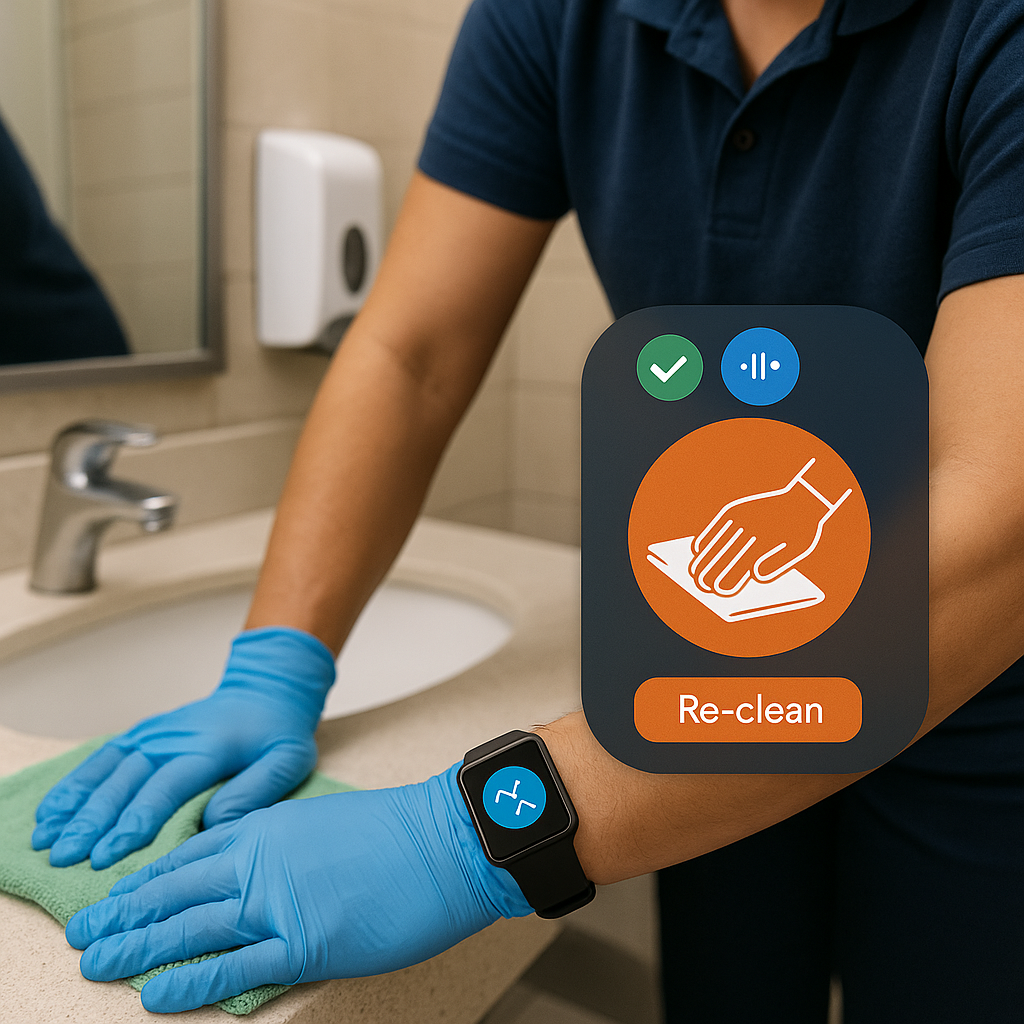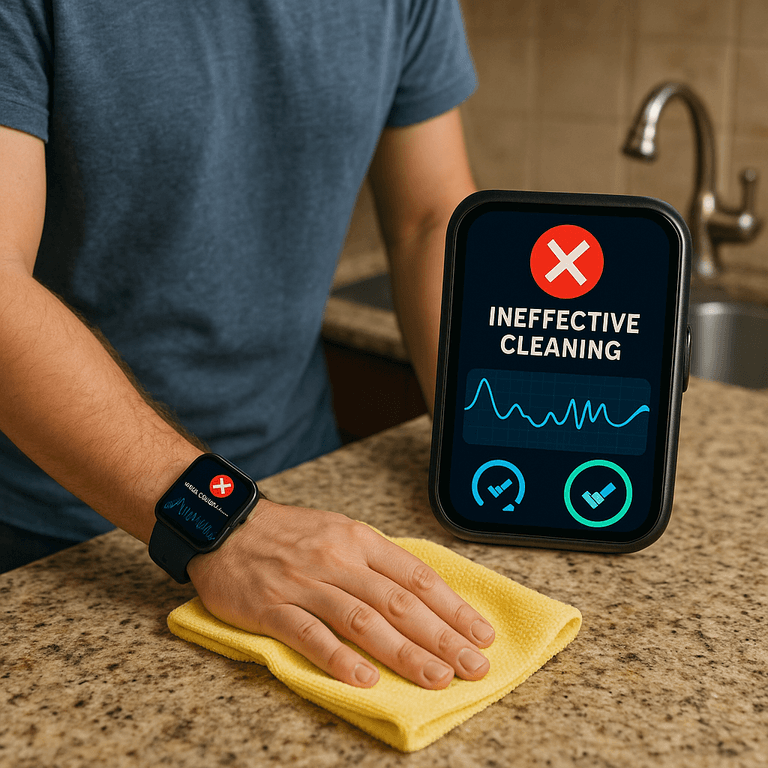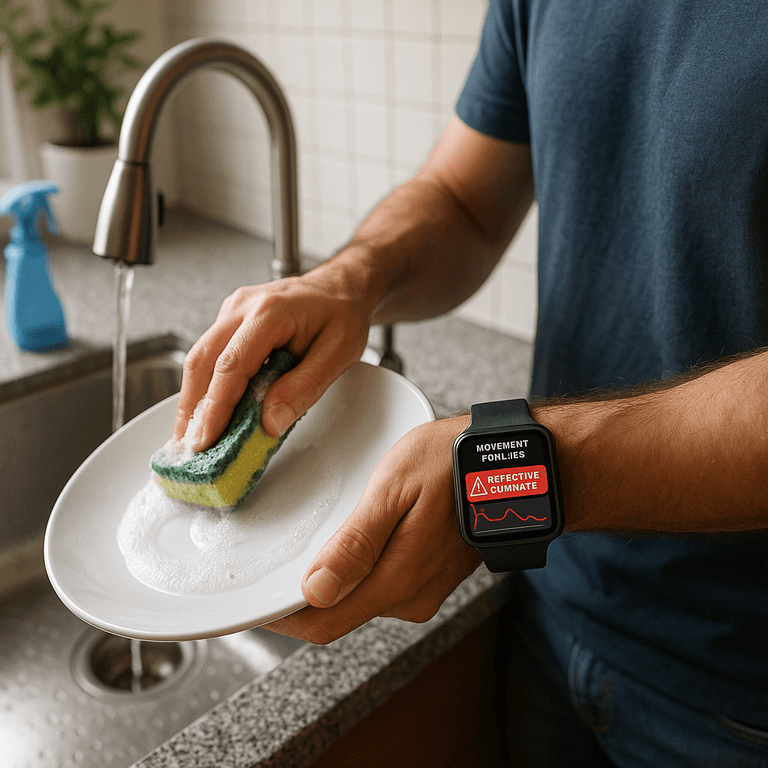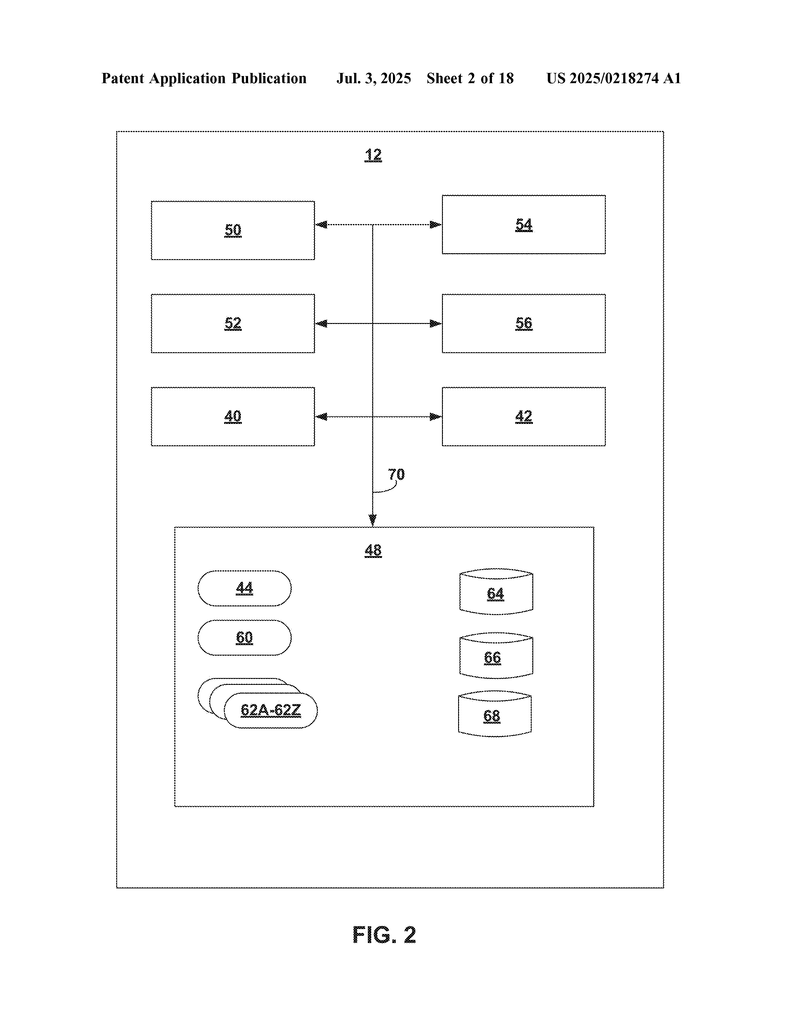Invented by Goldfain; Albert, Hayes; Gregory Bryant, Gaynor; Emily, Van Hoecke; Pedro, Weart; Ilona Furman, Wegner; Joseph
In today’s world, keeping things clean and safe is more important than ever. But how do we know if cleaning is done well enough to protect everyone’s health? This article explores a patented invention that uses wearable devices to make sure cleaning is done right, every time. Let’s take a close look at the reasons behind this invention, what made it necessary, how it builds on past ideas, and what is new and special about it.
Background and Market Context
Illnesses caused by poor cleaning are a huge problem. Every year, millions of people get sick because places like restaurants, hospitals, hotels, and public spaces are not cleaned well enough. For example, in the United States alone, about 48 million people fall ill from foodborne germs each year, leading to thousands of deaths. Hospitals also see a lot of infections that happen just because cleaning is not done right—sometimes as many as 10 out of every 100 patients get an infection they didn’t have before.
These problems are not just about dirty hands or missed spots. They cost money, take up hospital beds, and can even lead to deaths. In busy places, there are many surfaces and tools that lots of people touch—like doorknobs, tables, and kitchen counters. If these are not cleaned properly, germs can spread fast.
Most cleaning jobs are done by workers who are often new or do not stay long. This makes it hard for managers to make sure cleaning rules are followed every time. Sometimes, workers may not have enough training or may forget steps, especially when they are busy. Even if there are cleaning checklists, it is tough to know if every spot was cleaned well without watching every move.
To solve these problems, businesses need a way to check and prove that cleaning is done right. They want to make sure every surface is cleaned, that the cleaning is good enough, and that the right order of steps is followed. This is not just about catching mistakes, but also about helping workers do better, keeping everyone safe, and showing proof that cleaning was done in case something goes wrong.
Until now, most checks were done by supervisors walking around, random spot checks, or filling out paper forms. These methods are slow, can miss things, and do not give real proof that a place is truly clean. There is a growing demand for smart tools that can track cleaning as it happens, give feedback, and store records for later. This is where wearable technology steps in.
Scientific Rationale and Prior Art
The idea of using technology to check cleaning is not brand new. In the past, there have been timers to make sure people wash their hands for long enough. Other systems have used cameras to watch if a surface is cleaned. Some places use checklists on tablets, and a few use sensors that can tell if a soap dispenser was used.
But these older tools have big limits. Timers only know if time passed, not what was actually done. Cameras can be costly, feel invasive, and need someone to watch the footage. Checklists rely on people being honest, and sensors at soap dispensers don’t know if hands were washed well or if the rest of the cleaning was done at all.
Wearable devices, like smartwatches and fitness bands, have sensors that track movement. People already use these to count steps or track sleep. The idea behind this invention is to use those same sensors—like accelerometers (which tell if you move your arm) and gyroscopes (which tell if you twist your wrist)—to figure out when cleaning is happening.
Before this invention, no tool could automatically tell the difference between cleaning actions and regular movements (like scratching your head or opening a door), or tell what kind of cleaning was happening (like mopping the floor, scrubbing a counter, or washing hands). There also wasn’t a way to check if each cleaning action was done well enough—not just done quickly, but done with the right amount of effort, over the right area, and in the right order.
Some research in the past tried to use motion sensors to see if people were washing their hands, but these didn’t work well in real-world places with many different actions going on. They often confused cleaning with other movements. Also, they couldn’t track complex routines, like cleaning several surfaces in a row, or check if someone did the steps in the right order (for example, cleaning the floor before cleaning equipment, then washing hands at the end).
The need was clear: a smart, easy-to-wear device that could tell when cleaning was happening, know what was being cleaned, check if it was done well, and help people do better by giving alerts or reminders in real time. This would also let businesses keep records as proof of good cleaning. This invention meets that need in a way that older tools could not.
Invention Description and Key Innovations
This invention is about a method and device for total hygiene management using a wearable computing device—like a wristband, armband, or even a device in a pocket. Here’s how it works in simple terms.
The wearable device has sensors that track how the wearer moves. When the person is cleaning, the device collects data about their movements—how fast their arm moves, if they are turning their wrist, how long they keep moving, and more. The device uses this data to figure out:
1. Is the wearer performing a cleaning action?
The device looks for patterns in the movement data that match known cleaning actions. For example, the way someone wipes a table, mops a floor, or washes their hands each has a special pattern. The device learns these patterns by being trained with examples (either from the same person or from others).
2. What type of cleaning action is being done?
The device can tell if the wearer is cleaning a floor, cleaning equipment, or cleaning their hands. Each action uses different motions. The device checks the current movement against a library of patterns for different cleaning tasks.
3. How good is the cleaning?
It’s not enough to just know that cleaning happened. The device checks if the cleaning was done with enough effort, for enough time, and covered enough area. It does this by comparing the movement data with reference data (which shows what “good” cleaning looks like). If the cleaning isn’t good enough—maybe it was too short or not vigorous—the device knows.
4. Was the right cleaning order followed?
In many places, cleaning must be done in a certain order. For example, clean equipment before washing hands. The device keeps track of the order of actions and checks if it matches the required steps. If the wearer skips a step or does things in the wrong order, the device can tell.
5. What happens if cleaning isn’t up to standard?
If the device notices that a cleaning action was missed, done poorly, or done in the wrong order, it can perform an operation right away. This could be an alert—a beep, a vibration, a message on a screen—telling the wearer to fix the mistake. This feedback happens in real time or close to it, so the person can correct their actions before leaving the area.
6. What if cleaning is done well?
When the cleaning is done right, the device can store a record of it. This creates a digital log showing that cleaning was done properly, including what was cleaned, when, and by whom. This helps with audits, safety checks, and even rewarding good performance.
How does the device do all this?
The device uses at least one sensor (like an accelerometer or gyroscope) to get movement data. It can also connect to other devices or a remote computer (like a server or cloud) to process the data. Sometimes, the device does all the thinking itself; other times, it shares the data with a bigger computer that runs more complex checks.
The device can be worn on the wrist, arm, or even carried in a pocket. It has a user interface, which could be a touch screen, buttons, or just ways to buzz or beep. It can show messages, make sounds, or vibrate to get the wearer’s attention.
Key innovations include:
– Automatic detection of cleaning actions: The device doesn’t just record all movement. It picks out cleaning actions from other movements, so it knows when the person is actually cleaning.
– Identification of cleaning type: The device can tell the difference between cleaning a surface, cleaning equipment, and personal hygiene actions like handwashing.
– Assessment of cleaning quality: By comparing live movement data to stored examples of good cleaning, it knows if the job is done well enough.
– Order checking: The device tracks the sequence of cleaning actions and checks if it matches the required protocol.
– Real-time feedback: The device gives instant alerts if cleaning is missed or not up to standard, helping the wearer fix mistakes on the spot.
– Digital validation records: Every cleaning action can be logged as proof, helping with audits and compliance.
Training and adaptability:
The system can be trained for different users, surfaces, or places. It can be set up by having someone perform cleaning while wearing the device, so it learns the right patterns. This can be done with the actual worker or with a trainer. The device can be adapted for different environments, like hospitals, restaurants, schools, or factories.
Privacy and control:
The device is designed to respect privacy. Data can be made anonymous, and workers can have control over what is shared or stored. Location data can be generalized, so it does not track people too closely.
Practical impact:
By using this device, places can cut down on the spread of germs and infections. Studies and tests show that this system can reduce infection rates by a big amount—sometimes by more than half. It also helps managers see where more training is needed, or where cleaning steps are often missed.
Actionable use:
To get started, a business would set up the device for their cleaning staff. They would train it to recognize the cleaning actions needed for their environment. Workers wear the device while cleaning, and the system gives them feedback and stores records. Managers can review the records to spot any problems and make sure cleaning is always up to standard.
Why is this a big step forward?
This invention takes smart technology and applies it to a real-world problem in a way that is easy to use, gives real results, and fits into daily work without slowing anyone down. It turns every cleaning job into a measurable, trackable, and improvable action. This helps keep people safe, builds trust, and makes cleaning teams more effective.
Conclusion
Keeping places truly clean is not easy, but it is very important for health and safety. This patent shows how wearable technology can make a big difference. By tracking cleaning actions, checking their quality, and giving helpful feedback, this invention lets people clean better and helps businesses prove they are doing things right. It is a smart, simple, and powerful way to fight the spread of germs and keep everyone safer.
Click here https://ppubs.uspto.gov/pubwebapp/ and search 20250218274.




